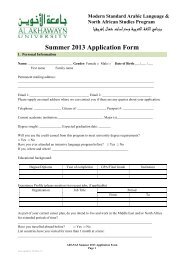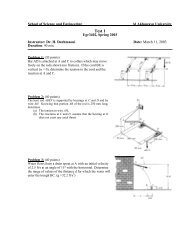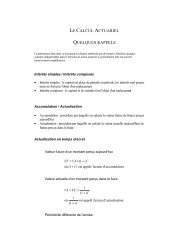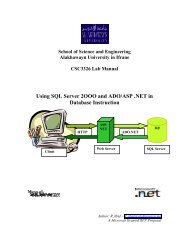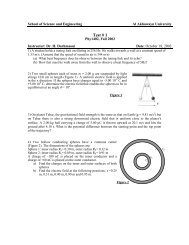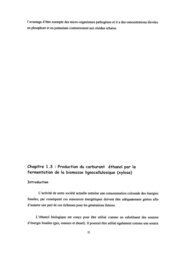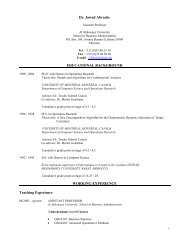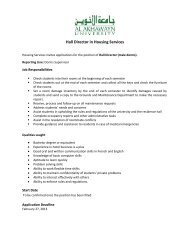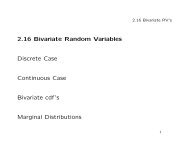Leadership and Values in Language Education - Al Akhawayn ...
Leadership and Values in Language Education - Al Akhawayn ...
Leadership and Values in Language Education - Al Akhawayn ...
- No tags were found...
You also want an ePaper? Increase the reach of your titles
YUMPU automatically turns print PDFs into web optimized ePapers that Google loves.
117Proceed<strong>in</strong>gs of the 27 th MATE Annual Conferenceover the structure <strong>and</strong> content of communication. In brief, as previously po<strong>in</strong>tedout there is a close <strong>in</strong>terrelationship between shared leadership <strong>and</strong> open pattersof communication, one of the major def<strong>in</strong><strong>in</strong>g elements <strong>and</strong> <strong>in</strong>novations broughtabout by shared leadership <strong>and</strong> communicative language teach<strong>in</strong>g, on the oneh<strong>and</strong> <strong>and</strong> between the traditional comm<strong>and</strong>-<strong>and</strong>-control models of leadership <strong>and</strong>traditional teacher-centred approaches to second <strong>and</strong> foreign language teach<strong>in</strong>g<strong>and</strong> learn<strong>in</strong>g. Therefore, shared leadership provides further arguments for theneed to implement more communicative approaches, which would berecommended here for successful practice of shared leadership <strong>in</strong> foreign <strong>and</strong>second language classrooms.2. 3. Small-group work <strong>and</strong> team-workThe patterns of communication <strong>in</strong> general <strong>and</strong> classroom communication <strong>in</strong>particular which have been dist<strong>in</strong>guished to foster participants’ active,productive, <strong>and</strong> creative participation <strong>and</strong> leadership shar<strong>in</strong>g <strong>in</strong> <strong>in</strong>teractivecommunication are generally student-students <strong>in</strong>teraction <strong>in</strong> problem solv<strong>in</strong>g,<strong>in</strong>formation-gap, <strong>and</strong> role-play activities <strong>in</strong> pair-work, small-group work, teamwork,<strong>and</strong> whole class discussion. These activities <strong>and</strong> patterns of organizationare recommended because they are student-engag<strong>in</strong>g <strong>and</strong> student-led <strong>in</strong> that their“major characteristic <strong>in</strong> terms of participation is that the student is primaryspeaker” (Vanlier, 1988: 173). Student-student(s) communication <strong>in</strong> small-groupwork activities provides an <strong>in</strong>teractional environment <strong>in</strong> which they couldpractice various speech acts, a communicative environment <strong>in</strong> which they couldshare a great deal of ideas, <strong>in</strong>itiate discourse, exchange op<strong>in</strong>ions, give <strong>and</strong> ask for<strong>in</strong>formation, give <strong>in</strong>structions, <strong>in</strong>terrupt <strong>and</strong> be <strong>in</strong>terrupted, <strong>and</strong> correct otherpeers <strong>and</strong> be corrected. Students’ self-motivated <strong>in</strong>volvement <strong>in</strong> such patterns oforganization would help them to develop their confidence <strong>in</strong> speak<strong>in</strong>g <strong>in</strong> public,develop personal characteristics, develop the skills of logical <strong>and</strong> creativeth<strong>in</strong>k<strong>in</strong>g, develop the skills of chair<strong>in</strong>g <strong>and</strong> many other shared leadership <strong>and</strong>group management abilities, develop the skills <strong>and</strong> traits of efficient <strong>and</strong>cooperative group work, <strong>and</strong> would also help them to develop the abilities toorganize <strong>in</strong>formation, ideas, <strong>and</strong> priorities, to develop problem solv<strong>in</strong>g strategies<strong>and</strong> the ability to cope with stress <strong>and</strong> complexity <strong>and</strong> to manage time. In brief,students’ engagement <strong>in</strong> such k<strong>in</strong>d of <strong>in</strong>teraction would help them practicevarious skills <strong>and</strong> competencies of shared leadership, which are essentially<strong>in</strong>teractional, managerial, <strong>and</strong> communicational <strong>in</strong> nature at the l<strong>in</strong>guistic <strong>and</strong>social levels.2. 4. Classroom communicative competence




